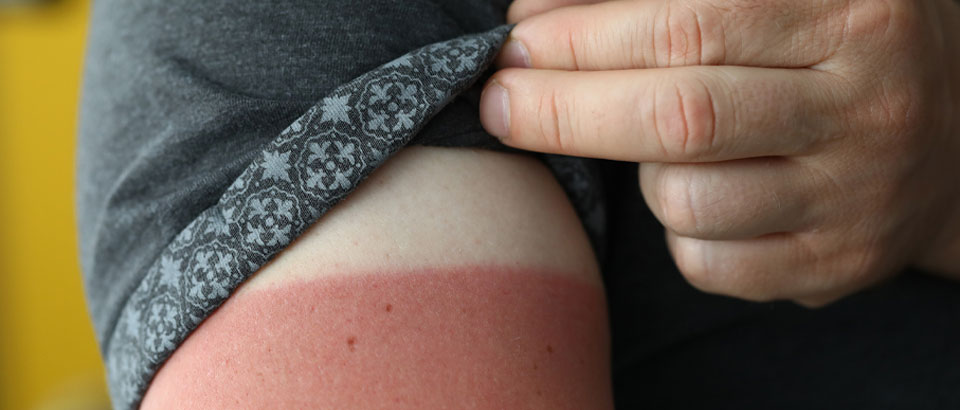August 23, 2022
You’ve heard of the term, but do you know what sun poisoning really is? It actually has nothing to do with poisoning and more to do with an allergic reaction on the skin from the sun. It’s a sun-induced rash in those who have developed sensitivity to sunlight. It typically appears as an itchy rash in sun-exposed areas hours to days after sun exposure and lasts several days before disappearing. Here’s your guide to the signs and treatment of sun poisoning and how you can prevent it.

Polymorphic Light Eruption (Sun Poisoning Rash)
The most common rash caused by sunlight is sun poisoning, also known as polymorphic light eruption (PMLE). It can take many distinct forms depending on your sensitivity to the sun. PMLE is a rash that develops as a result of sun exposure and is typically characterized by small, red bumps or slightly elevated patches of skin that are extremely itchy. Indeed, as previously stated, PMLE is a kind of photodermatoses, which is an unusual reaction to sunlight, most commonly the ultraviolet (UV) rays.
A PMLE rash is going to be an itchy rash that typically presents the same way in an individual each time they are sun exposed. Sun poisoning can start with the soreness you associate with a typical sunburn and be mistaken for it when you notice the red shoulder or thigh that goes white when you press your finger across it. After a few hours, however, things can start to go wrong when a scorching rash appears on your skin that itches and burns like crazy. While less likely, you may experience chills and/or become exceedingly thirsty. You might even feel nauseous. These are some of the signs and symptoms of sun poisoning. Polymorphic light eruption is brought on by UV radiation changing a substance in the skin, to which the immune system responds by inflaming the skin.2
Anyone can get PMLE, although it’s more common for people with lighter color skin and hair. The people most at risk of getting sun burn or poisoning are people with Fitzpatrick skin type 1. The Fitzpatrick skin types scale was created in 1975. It’s the system that classifies skin types according to the amount of pigment your skin has and your skin’s reaction to sun exposure. The Fitzpatrick skin type 1 is commonly recognized as an ivory skin color, light blue, light green, or light gray eyes and is typically paired with red or light blonde hair. The sun’s reaction on this skin type is normally to freckle, burn or peel when exposed. Women are nearly four times as likely to experience PMLE than males. Although the symptoms could appear at any age, they usually appear between the ages of 20 and 40. Additionally, it happens more commonly in areas with greater elevations and temperate climates.
Sun Poisoning Symptoms
We've all heard about sun poisoning, but how easy is it to identify when you have it? It usually presents itself as an itchy rash that occurs on sun exposed areas (arms, hands, chest, legs, feet), usually within hours of sun exposure. It can be similar to other allergic rashes, but usually resembles previous episodes in the same individual. Rarely, symptoms such as fever, headache, and nausea may be present. It can also take a few hours or days for the redness and discomfort of the rash to appear. There’s individual variation in the amount of UV exposure required to trigger PMLE, which can be different for everyone. However, the risk of developing the rash, and serious sunburns, goes up if you stay in the sun for long periods of time. That is especially true when not properly wearing sunscreen.
The exact cause of PMLE isn’t known. However, people who have a heightened sensitivity to sunlight, particularly UV radiation from the sun or other sources like tanning beds, get the rash. The term for this is photosensitivity. It triggers immune system activity, which results in an itchy rash. Polymorphic means “many forms,” and PMLE can look different for different people. Sun poisoning rash can manifest itself in a variety of ways (depending on the severity). These may include the following:
- Skin redness and blistering
- Severe bumpy rash
- Pain and tingling
- Swelling and intense itching
- Headache
- Fever and chills
- Nausea
- Dizziness
- Dehydration
If you're experiencing any of these symptoms, it's critical that you drink lots of water and electrolytes to stay hydrated and alert. If you're feeling sick, nauseated, dizzy, or otherwise ill, it's likely that you're severely dehydrated and should seek medical attention. If you spot any oozing, increased redness, or streaking, it could indicate a developing infection and medical attention should also be sought immediately.

What is the Difference Between Sunburn and Sun Poison?
It's sometimes difficult to distinguish between sunburn and sun poisoning. Sunburn is an acute injury to skin, resulting from sun exposure that can vary in severity. Sun poisoning is a recurrent condition that occurs in susceptible individuals due to an allergic response to UV rays. A sunburn is a temporary redness of the skin that goes away after a few days.
It's probably sunburn if it's smooth and is most likely sun poisoning if it is lumpy. A sunburn usually goes away after a few days, but a PMLE rash typically lasts longer. After you have been exposed to the sun for an extended period of time without adequate protection, blisters or a solar rash are common symptoms, though the severity varies depending on the person and amount of exposure. PMLE is likely in those that tend to break out in similar, itchy rashes each year after sun exposure. However, it may be a good idea to see your medical professional as they can help make the diagnosis and rule out other causes.
How Can You Prevent Sun Poisoning?
The best way to avoid symptoms of PMLE is by taking steps to prevent it. It all starts with following the basics of sun safety. Wear sunscreen with at least an SPF of 30 and the words "broad-spectrum" on the label, which implies it protects against both UVA and UVB rays from the sun. Apply it to your entire body 15 to 30 minutes before going outside in the sun. Reapply at least every two hours and after being in the water or sweating. PMLE can also be caused by sunlight through a window so make sure to wear sunscreen inside and outside.
It’s also a good idea to limit your sun exposure between 10 a.m. and 2 p.m., and keep in mind that water, snow and sand can magnify the sun's harmful rays. Yes, that’s right – sunburn isn’t just a concern for the summertime! Protect yourself by using sunglasses, a hat, and protective gear. We recommend covering up with long sleeves or a broad-brimmed hat if you're going to be out in the sun for an extended amount of time.
Last but not least, don't rely solely on sunscreen and other forms of UV protection to keep you safe from the sun. Move to a shady spot if you start to burn or if your skin becomes red, bumpy, or irritated from the sun.
Sun Poisoning Treatment
Depending on the degree of the burn, sun poisoning can continue for weeks. You can also face the danger of getting an infection if you scratch or pick at the burn. If you detect any bleeding or oozing, you should seek medical attention because it could be an indication of infection and require proper care.
The majority of sunburns and sun poisoning can be treated at home. Some methods for reducing pain or discomfort include:
- Rehydrate with water, electrolyte-containing beverages or IV fluids.
- Use a cool (but not freezing) compress, cool baths, aloe vera gel or steroid cream to soothe the sore area.
- Avoid scratching or bursting blisters.
- Exfoliate peeling skin gently.
- Additional sun exposure should be avoided.
- Ibuprofen or naproxen can help relieve discomfort and reduce swelling.
- Apply an anti-itch cream or take an oral antihistamine.
- Protect the rash from any more sun exposure and stay covered up.
With repeated exposure, sensitivity to sunlight decreases in polymorphous light eruption. Some characteristics of polymorphous light eruption are predictable:
- After a prolonged period of no exposure to the sun, such as in the spring or early summer, an episode is most likely to happen after the first one or two exposures.
- The duration of episodes decreases as the summer goes on.
- After the first occurrence, it probably occurs yearly. Over several years, some people progressively lose their sensitivity and eventually stop getting the yearly rash.
While sunburn can be managed at home, sun poisoning may need medical attention. If you are experiencing any severe symptoms of discomfort, our friendly medical team is available to treat you and get you back to feeling better. Our neighborhood medical centers offer convenient weekend and evening hours, so you can schedule an appointment or just walk in at a time that fits your schedule.
References:
1 Healthline: Overview of Polymorphous Light Eruption (Sun Allergy). Last updated May 9, 2022. Accessed May 14, 2022.
2 NHS: Polymorphic light eruption. Last updated July 28, 2021. Accessed May 14, 2022.
3 Optum Hospice Pharmacy Services LLC: Polymorphous light eruption. Last updated March 25, 2021. Accessed May 14, 2022.
4 Mayo Clinic: Polymorphous light eruption. Last updated March 15, 2022. Accessed May 14, 2022.
5 Healthline: Sun Poisoning. Last updated on September 28, 2018. Accessed May 14, 2022.
